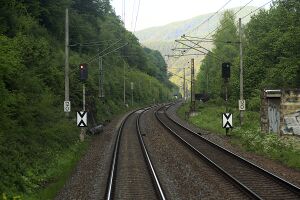Dev:Border between infrastructure managers and countries: Difference between revisions
| [checked revision] | [checked revision] |
m (RailML Orga Ontology moved page Dev:Handover point to Dev:Border between infrastructure managers and countries: changed a name to make it more understandable) |
No edit summary |
||
| Line 1: | Line 1: | ||
The overarching objective of the EU Directive 2012/34/EU is to establish a single European railway area. Contributing to this objective is the requirement for improved cooperation of infrastructure managers and ‘cross-border agreements’, to enable seamless operations for train paths crossing borders, or ‘handover points’ (defined in <ref>{{external|http://taf-jsg.info/wp-content/uploads/2023/07/20230426-JGS-Handbook-3.3-with-XSD-3.3.0.0.pdf|TAP TSI and TAF TSI Sector Handbook for the Communication between Railway Undertakings and Infrastructure Managers (RU/IM Telematics Sector Handbook) Submitted on 20th October 2022}}</ref>: as “the point where legal responsibility changes between the infrastructure mangers”). | |||
[[File:2023-11-29 railML handoverPoint.jpg|thumb|Border between infrastructure managers Správa železnic | [[File:2023-11-29 railML handoverPoint.jpg|thumb|Border between infrastructure managers Správa železnic in the Czech Republic and Deutsche Bahn Netz in Germany]] | ||
The photo shows an example of a ‘handover point’ at the Germany-Czech Republic border on the Děčín to Dresden-Neustadt 6240 railway line. This line is operated by two different rail operating companies, Správa železnic in the Czech Republic and Deutsche Bahn Netz in Germany, meaning there is a change in infrastructure managers. | |||
In the source code there are two tracks belonging to two infrastructure mangers. Ownership is represented by {{tag|IS|ownerChange}} elements. Further information is given in the {{tag|CO|infrastructureManager}} element and corresponding | |||
{{site|1=https://wiki2.railml.org/wiki/Dev:InfrastructureManagers|2=code list}}. | {{site|1=https://wiki2.railml.org/wiki/Dev:InfrastructureManagers|2=code list}}. | ||
<syntaxhighlight lang="xml"> | <syntaxhighlight lang="xml"> | ||
| Line 25: | Line 25: | ||
</syntaxhighlight> | </syntaxhighlight> | ||
It is important to ensure the correct definition of the railway tracks. Every railway track should have an {{tag|IS|ownerChange}} at the beginning of the track positioned at a zero coordinate. Additional semantic constraints apply for the {{tag|IS|speedChange}} <ref>{{site|1=https://www.railml.org/forum/index.php?t=msg&th=905&start=0&|2=railML2 <speedChange> semantic constraints revision forum post}}</ref>. | |||
== References == | == References == | ||
Revision as of 12:54, 5 December 2023
The overarching objective of the EU Directive 2012/34/EU is to establish a single European railway area. Contributing to this objective is the requirement for improved cooperation of infrastructure managers and ‘cross-border agreements’, to enable seamless operations for train paths crossing borders, or ‘handover points’ (defined in [1]: as “the point where legal responsibility changes between the infrastructure mangers”).
The photo shows an example of a ‘handover point’ at the Germany-Czech Republic border on the Děčín to Dresden-Neustadt 6240 railway line. This line is operated by two different rail operating companies, Správa železnic in the Czech Republic and Deutsche Bahn Netz in Germany, meaning there is a change in infrastructure managers. In the source code there are two tracks belonging to two infrastructure mangers. Ownership is represented by <ownerChange> elements. Further information is given in the <infrastructureManager> element and corresponding code list (link to the railML® website).
<metadata>
<organizationalUnits>
<infrastructureManager id="ima01" code="DBN"/>
<infrastructureManager id="ima02" code="SZD"/>
</organizationalUnits>
</metadata>
..
<trackBegin id="tb01" pos="0" absPos="0">
<ownerChange id="och01" pos="0" absPos="0" infrastructureMamagerRef="ima01"/>
..
<trackEnd id="tb01" pos="500" absPos="500">
..
<trackBegin id="tb02" pos="0" absPos="500">
<ownerChange id="och02" pos="0" absPos="500" infrastructureMamagerRef="ima01" name="Bahnverw.grenze Bad Schandau Gr"/>
..
<trackEnd id="tb02" pos="500" absPos="1000">
It is important to ensure the correct definition of the railway tracks. Every railway track should have an <ownerChange> at the beginning of the track positioned at a zero coordinate. Additional semantic constraints apply for the <speedChange> [2].
